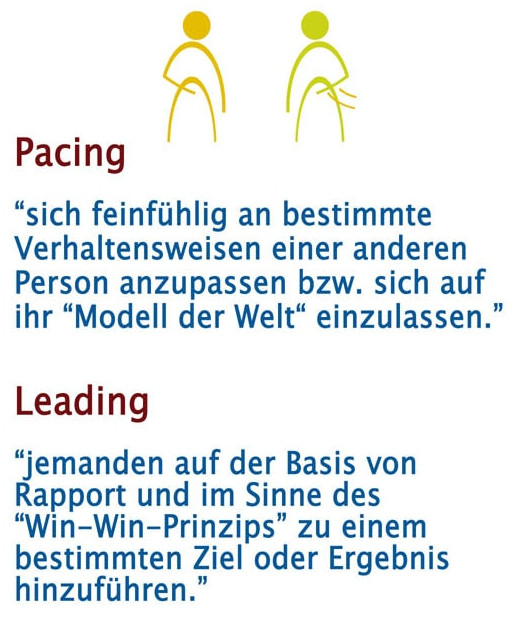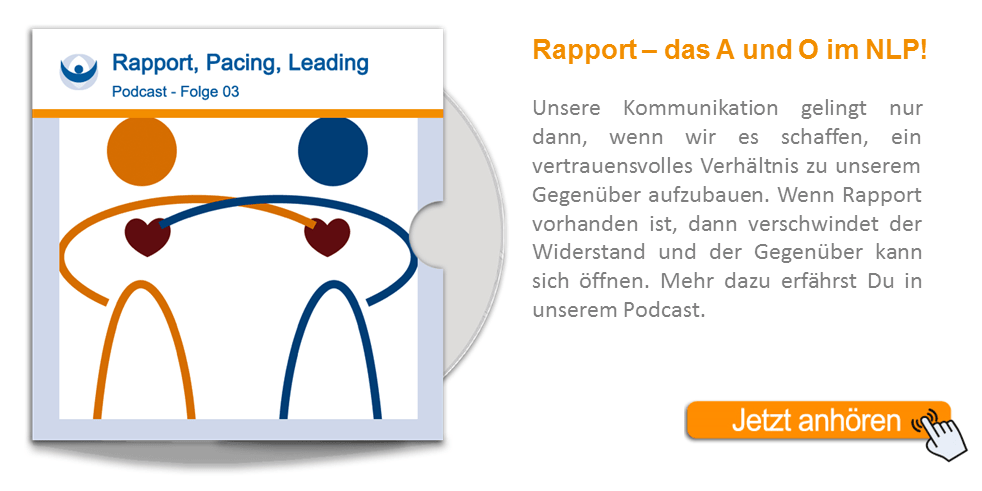Building Rapport with Pacing and Leading
The prerequisite for any good communication is trust. Most people have only a few solid strategies to create affinity with others. NLP teaches a set of highly effective methods to bring yourself closer to others and build a bridge.

Table of Contents
- Rapport
- Pacing and Leading
- Exercise: Pacing and Leading
- Exercise: Matching and Mismatching
- Exercise: Pacing Statements
- More Practice Ideas
Rapport
Rapport is the ability to step into another person’s world and build a bridge to them. It is a relationship characterized by agreement, alignment or similarity. Rapport means addressing people at their level and using their language so they can grasp ideas that would be missed if presented in a different form.
It is the art of gaining others’ support and cooperation to achieve a shared goal. When rapport is present, resistance melts away. Rapport involves building deep contact with the other person’s unconscious—getting on the same wavelength. It arises through conscious or unconscious alignment.
What is Rapport? Stephan Landsiedel explains
Applying Rapport
Pacing and Leading

Repeated observation shows that people who like each other and have deep contact naturally align their expressive behavior. The reverse also works: by aligning your expression to another person, you can build rapport.
- Mirroring means physically aligning posture, gestures, breathing, facial expression, movements or weight shifts, muscle tone, etc. You reflect anything you can see—like a mirror.
- Pacing means aligning to the other person’s overall visual and auditory expression. You meet them where they are. For instance, pace their speaking rate, rhythm, and tone. Mirroring behaviors also belongs here.
- Matching goes a step further: align to language style (e.g., representational systems) and patterns (e.g., meta programs).
Leading: After aligning for a while and establishing rapport, you can begin to lead—gently guiding the direction of the interaction toward a desired outcome—always in the spirit of a win-win.
With the win-win principle, a conflict resolution or negotiation outcome benefits both parties so both can view themselves as winners. Unlike strategies that seek only one-sided gain, win-win respects the interests of the other. It’s tied to positive intent and honest compromise, with focus on a good result for both sides. Sometimes it takes creativity to find such solutions.
I also suggest expanding this to a win-win-win principle: not only both parties gain, but the wider system (organization, society) benefits too.
Cross-Over Mirroring
Cross-over mirroring is a special form of pacing/mirroring: you mirror either in a different representational system or with a different type of movement.
Example: your partner is pacing back and forth—mirror their rhythm by moving your fingers, or by subtly rocking your torso forward and back.
A classic case is an asthmatic who is breathing heavily right before an attack. If you pace their breathing directly, you risk adopting the same pattern. Instead, mirror the breathing rhythm in another system—e.g., by tapping your hand or nodding your head.
Tip: Cross-over mirroring does not primarily mean mirroring a right-arm movement with your left leg; that’s just a quirky example. Overall, cross-over mirroring is a very effective way to build rapport.
Exercise: Pacing and Leading (Align & Lead)
In pairs: A and B, about 5–10 minutes
- A moves their whole body; B aligns to A.
- After a while, B gently begins to lead. A follows.
- Continue with soft switches between pacing and leading so a “dance” emerges.
These whole-body movements can be replaced with any of the following rapport-building behaviors:
- Breathing rhythm
- Posture, small body movements (gestures)
- Micro-movements (e.g., frowning, foot tapping)
- Voice volume, speaking rate
- Language patterns and key words
- Blink rate
With practice, pace/lead two or more behaviors at once. A and B can also pace/lead different behaviors.
Also practice cross-over mirroring, e.g.: mirror breathing with a leg movement, blinking with a finger movement, crossed arms with crossed legs, speech rhythm with head movement, etc.
You can test rapport by switching from pacing (aligning) to leading (guiding) and noticing whether the other follows. The easier they follow, the stronger the rapport.
If they don’t follow, return to pacing and try leading again later.
Exercise: Matching and Mismatching
Groups of three: A, B and C. About 10 minutes, then rotate roles.
- A talks about something from life (e.g., a trip, work, art, culture, etc.).
- B listens and paces (mirrors) A in at least three behaviors (e.g., posture, breathing rhythm, speaking speed—cross-over mirroring if useful).
- After a few minutes, B breaks rapport by shifting the mirrored behaviors.
- After a short time, B returns to pacing.
- C notes observable changes during the switches.
- A and B share how their inner experience changed through the switches.
- C reports observations (sensory-specific: what did you see and hear?).
With practice, pace/lead two or more behaviors at once. A and B can also pace/lead different behaviors.
Exercise: Pacing Statements
Recall a typical situation in which you communicate with others.
- Sensory observations
List three things you can perceive in the imagined situation. What do you see, hear and/or feel?
Weave these observations into your conversation. - Truisms
List three truisms or facts that apply in the imagined situation. Weave these into your conversation.
More Practice Ideas
- When you’re out and about—on the street, in restaurants, at events—observe whether people are in rapport or not.
- Mirror others’ movements to build rapport.
- Call a friend and pace their speaking speed and volume on the phone. Notice their favorite phrases.
- Pace someone’s current mood, then lead them to a better one.
- With your partner, pace their breathing when you’re close.
- Practice the pacing rhythm: Pacing, Pacing, Leading!

 Deutsch
Deutsch English
English Français
Français 中文
中文 Español
Español नहीं
नहीं Русский
Русский
